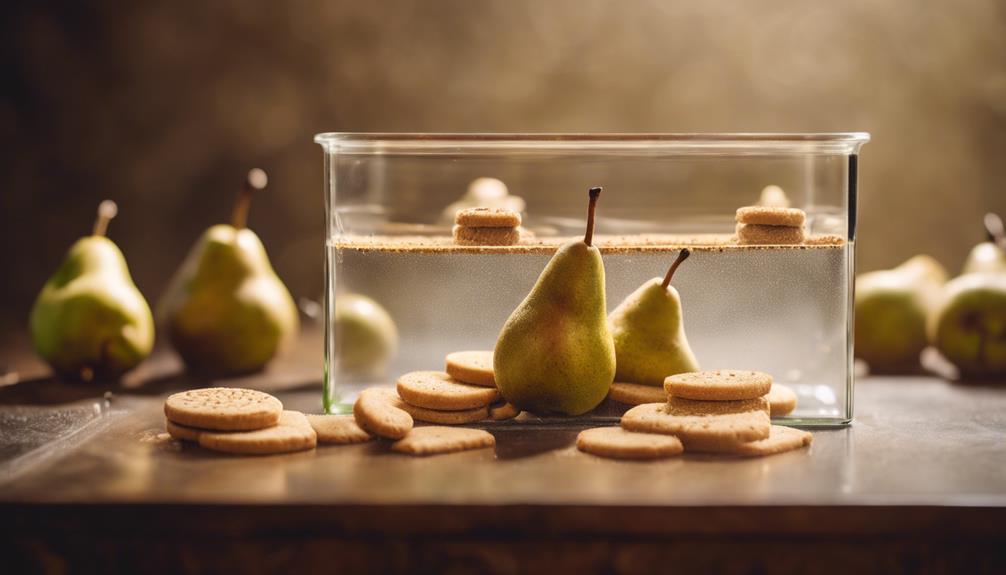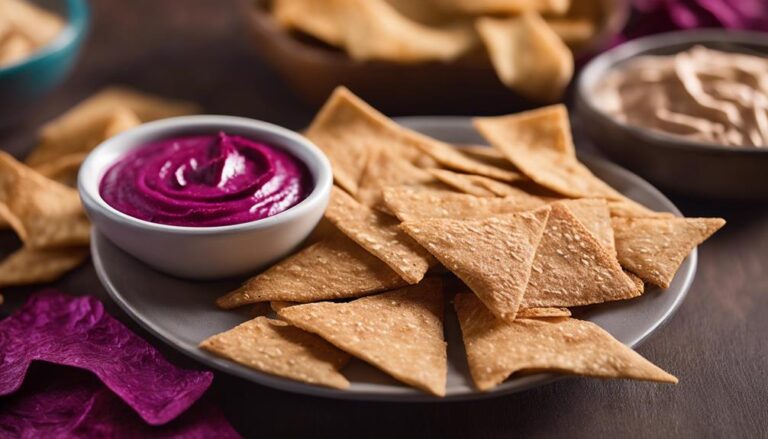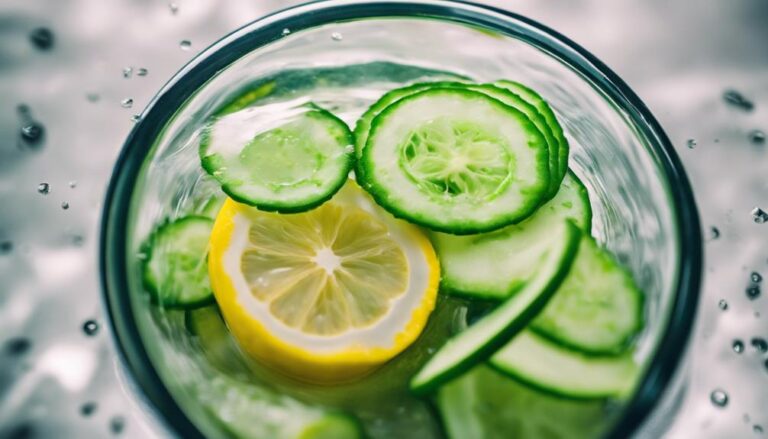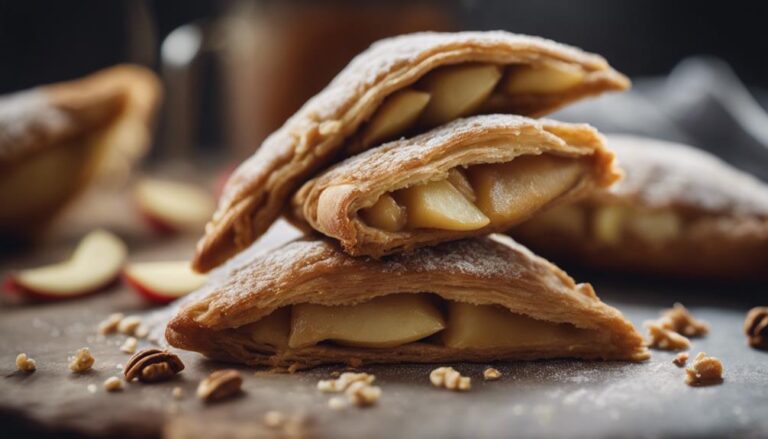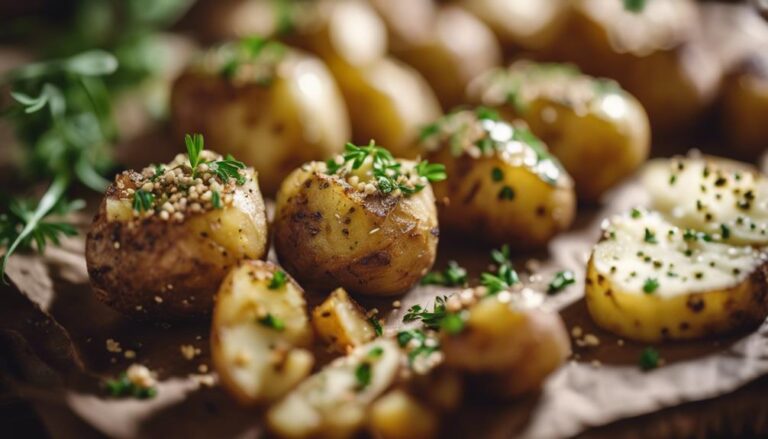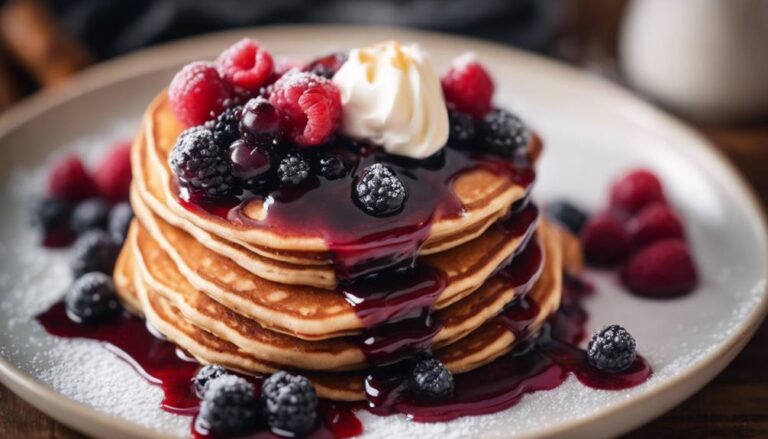Sous Vide Poached Pears With Whole Wheat Shortbread
Discover the precision of sous vide for perfect poached pears with whole wheat shortbread. Elevate flavors and textures through meticulous preparation. Sous vide offers even cooking and flavor preservation, unlike traditional methods. The sweet spice blend enhances the natural sweetness of pears. Trending desserts like Sous Vide Pear Tartlets showcase culinary innovation. Maintain ideal temperatures for best results. Consider contrasts in presentation for a visually appealing dish. Reach culinary excellence through careful pairing. Unravel the secrets of creating a harmonious blend of flavors and textures.
What You Will Learn Here
- Sous vide method ensures precise poaching for perfectly cooked pears.
- Whole wheat shortbread adds a wholesome, nutty contrast to the soft pears.
- Pairing offers a balance of textures and flavors for a sophisticated dessert.
- Presentation should focus on showcasing the elegance of poached pears.
- Utilize garnishes like fresh herbs or a drizzle of honey for visual appeal.
Pear's Poaching Origins
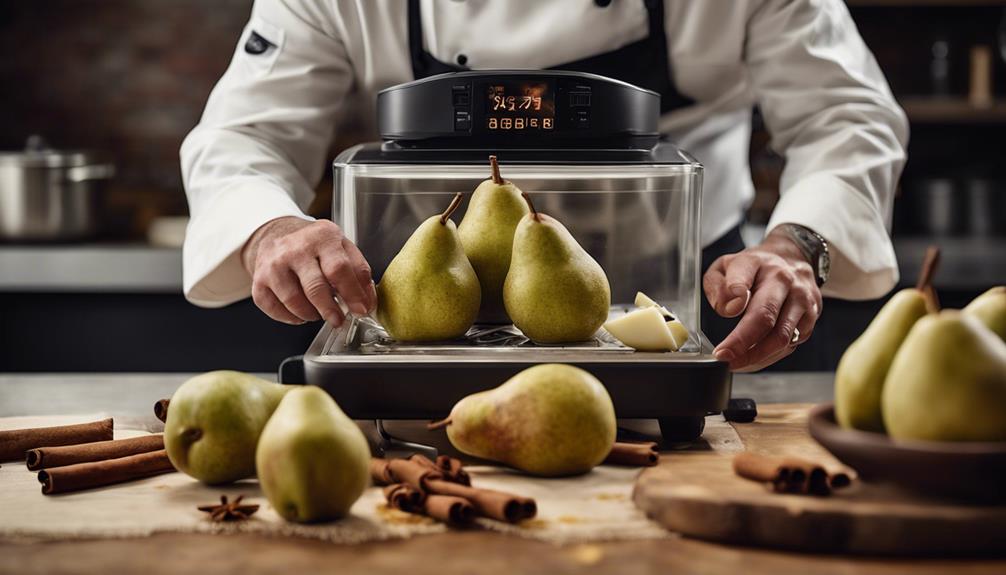
When considering the origins of pear poaching, it's essential to examine the history and methods behind this culinary technique.
Traditional pear preparation techniques offer valuable insight into the evolution of poaching practices.
Understanding the culinary significance of pears can provide a deeper appreciation for the art of poaching these fruits.
Poaching History and Methods
Poaching pears has been a culinary practice dating back centuries, with various methods developed over time to enhance the flavor and texture of the fruit. When exploring the historical roots of poaching, traditional techniques like simmering in a syrup on a stovetop were commonly used. However, with modern techniques, including sous vide innovation, the process has evolved to precise temperature control in a water bath. This method guarantees that the pears are evenly cooked and retain their shape and delicate taste. The table below summarizes the comparison between traditional poaching methods and the sous vide approach:
| Aspect | Traditional Techniques | Sous Vide Innovation |
|---|---|---|
| Temperature Control | Low heat on stovetop | Precise water bath control |
| Cooking Time | Variable | Consistent |
| Texture of Pears | Potential inconsistency | Evenly cooked and tender |
Traditional Pear Preparation
Exploring the historical roots of poaching pears reveals the traditional methods used in preparing this delicate fruit for centuries. Pear preservation in ancient times relied heavily on techniques like pickling, drying, and storing in honey or syrup to extend the fruit's shelf life.
These methods not only preserved the pears but also enhanced their flavors, creating a range of taste profiles that could be enjoyed year-round. Historical methods of pear preservation often included infusing the fruit with spices like cinnamon, cloves, and star anise to add depth and complexity to the flavor.
While modern trends have shifted towards lighter, fresher pear flavor pairings, understanding these traditional preservation methods can provide valuable insights into the culinary versatility of this beloved fruit.
Culinary Significance of Pears
The culinary significance of pears lies in their historical roots as a versatile fruit that has been traditionally preserved and enhanced through various methods. Poaching, a culinary technique used for centuries, delicately cooks pears in a flavorful liquid, enhancing their natural sweetness and texture. This method allows the fruit to absorb the infused flavors while maintaining its shape, making it a popular choice for desserts.
Beyond their culinary applications, pears offer notable health benefits. Packed with dietary fiber, vitamin C, and antioxidants, pears contribute to digestive health, immune function, and overall well-being. By comprehending the origins of pear poaching and incorporating this technique into your culinary repertoire, you can fully realize the potential of this fruit while promoting health-conscious cooking practices.
Pears' Sweet Spice Blend
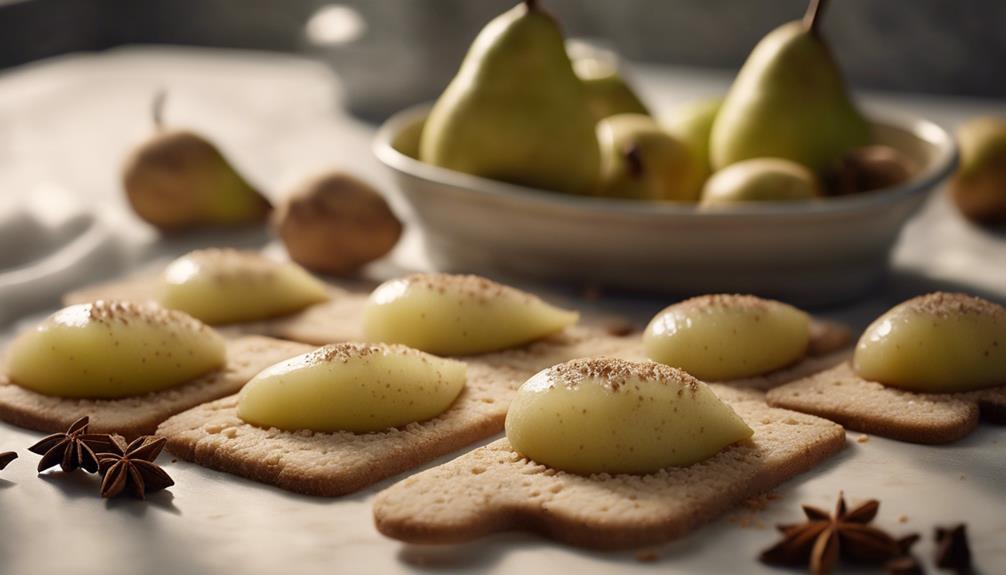
To enhance the flavor profile of the poached pears, consider incorporating a blend of sweet spices such as cinnamon, nutmeg, and cloves. These spices not only complement the natural sweetness of the pears but also add depth and warmth to the dish. Here are some key points to keep in mind when creating a sweet spice blend for your poached pears:
- Cinnamon: This spice is a classic choice for adding a warm, sweet flavor to the pears. It pairs exceptionally well with the fruit's natural taste, enhancing its overall appeal.
- Nutmeg: Adding a hint of nutmeg can elevate the dish by providing a slightly nutty and aromatic undertone. Be cautious with the quantity as nutmeg can quickly overpower other flavors.
- Cloves: Cloves offer a rich, pungent flavor that complements the sweetness of the pears. Use them sparingly to avoid an overpowering taste.
- Balance: When blending these spices, aim for a harmonious balance where each component contributes to the overall taste without overshadowing the delicate flavor of the poached pears.
Trending Pear Desserts
Trending pear desserts are gaining popularity, with options like Sous Vide Pear Tartlets, Sous Vide Pear Custard, and Sous Vide Pear Sorbet leading the way. These innovative creations showcase the versatility of pears in culinary applications, offering a range of textures and flavors to explore.
Incorporating sous vide techniques elevates traditional pear desserts, providing precise control over temperature and enhancing the fruit's natural sweetness.
Sous Vide Pear Tartlets
When aiming to create delectable and visually appealing desserts using sous vide techniques, consider exploring the domain of Sous Vide Pear Tartlets. These mini pastries offer a delightful combination of tender pear slices and buttery pastry, showcasing the perfect fruit pairing.
Here are some key points to keep in mind:
- Precision: Guarantee precise cooking times to achieve a tender yet firm texture in the pears.
- Balance: Find the ideal balance between the sweetness of the pears and the richness of the pastry.
- Presentation: Pay attention to the presentation, as the visual appeal of these tartlets can elevate the overall dining experience.
- Flavor Infusion: Experiment with different flavor infusions to enhance the natural sweetness of the pears.
Sous Vide Pear Custard
For a delectable twist on traditional desserts, consider exploring the world of Sous Vide Pear Custard, a trending option among pear-based delicacies. When delving into the domain of Sous Vide Pear Custard, keep in mind the following to enhance your culinary experience:
- Creamy Texture: The sous vide method guarantees a velvety smooth custard that melts in your mouth.
- Balanced Flavors: Pair the subtle sweetness of pear custard with complementary flavors like vanilla, cinnamon, or a hint of cardamom.
- Artful Presentation: Elevate your dessert presentation by garnishing with caramelized pear slices or a sprinkle of toasted almonds.
- Temperature Precision: Master the art of sous vide cooking to achieve the perfect custard consistency every time.
Explore the art of Sous Vide Pear Custard with confidence using these tips for a memorable dessert experience.
Sous Vide Pear Sorbet
To continue exploring innovative pear-based desserts, consider venturing into the domain of Sous Vide Pear Sorbet for a revitalizing and palate-cleansing treat.
When making this frozen delight, you're delving into the world of fruit preservation techniques, ensuring the pears' freshness and flavor are locked in.
The process of creating Sous Vide Pear Sorbet involves precisely controlling the temperature to extract the maximum essence from the fruit, resulting in a vibrant and intense pear flavor.
This frozen treat offers an invigorating experience, perfect for cleansing the palate after a rich meal. By utilizing the sous vide method, you're guaranteeing a smooth and creamy texture that will leave your guests impressed and satisfied.
Poaching Temperature Suggestions
When poaching pears sous vide, the ideal temperature range typically falls between 165°F to 185°F for best results.
Variations in poaching temperatures can directly impact the texture and flavor profile of the pears, so precision is key.
Achieving perfect poaching involves maintaining a consistent and controlled temperature throughout the process.
Ideal Poaching Temperatures
Achieve ideal results by setting the poaching temperature between 175°F and 185°F for perfectly tender and flavorful pears. Maintaining this essential temperature range is vital for enhancing the flavor profiles of the pears and ensuring excellent texture control.
When poaching within this temperature window, the pears will gently cook, allowing them to retain their natural sweetness and delicate taste. This controlled heat also helps in infusing any added spices or aromatics evenly throughout the fruit.
Additionally, cooking times can be accurately managed at these temperatures, preventing the pears from becoming mushy or overly soft. By following these poaching techniques and keeping the temperature within the recommended range, you'll be able to serve exquisitely poached pears that will delight your guests.
Temperature Variations and Effects
Considering the impact of temperature variations on poaching outcomes, what range of temperatures would be most important for achieving best results when poaching pears?
Temperature accuracy is essential in sous vide techniques as it directly affects the texture and flavor of the final dish. For poaching pears, a temperature range between 175°F to 185°F (79°C to 85°C) is recommended.
At lower temperatures, the pears may not soften adequately, while higher temperatures can cause them to become mushy. Maintaining a precise temperature guarantees that the pears poach evenly and retain their shape and flavor.
The benefits of sous vide techniques lie in their ability to control temperature with precision, resulting in consistently excellent poached pears with a perfect texture and taste.
Achieving Perfect Poaching
To guarantee ideal results when poaching pears, maintaining a precise temperature range between 175°F to 185°F (79°C to 85°C) is crucial. When utilizing sous vide techniques for poaching, this temperature range guarantees that the pears cook evenly without becoming mushy or losing their shape.
The controlled environment of sous vide cooking allows for a consistent temperature, resulting in perfectly poached pears every time. This temperature range is perfect for infusing the pears with the poaching liquid, enhancing their natural flavor profiles.
Final Thoughts
In conclusion, it's essential to consider the overall balance of flavors and textures when serving sous vide poached pears with whole wheat shortbread. When exploring texture, consider the soft, delicate nature of the poached pears against the slightly crunchy whole wheat shortbread. This interplay creates a delightful contrast that elevates the dining experience. Additionally, the flavor pairings between the sweet, spiced pears and the nutty, buttery shortbread should be harmonious. The pears shouldn't overpower the shortbread, but rather complement its earthy notes.
In your final presentation, make sure that each component is showcased effectively. Arrange the poached pears gracefully on the plate, allowing their natural juices to mingle with the shortbread. Consider garnishing with a light dusting of cinnamon or a dollop of fresh cream to enhance the overall aesthetic. Remember, the goal is to create a dish that not only pleases the palate but also delights the eyes. By paying attention to these details, you can transform a simple dessert into a culinary masterpiece.
Frequently Asked Questions
Can Other Fruits Be Poached Using the Same Method?
Yes, you can poach various fruits like apples, peaches, and plums using sous vide techniques. This method provides precise temperature control, resulting in perfectly cooked fruits with enhanced flavors and textures. Try experimenting with different fruits for unique desserts.
What Are Some Creative Toppings for the Poached Pears?
To enhance poached pears, consider toppings like toasted nuts for crunch, honey drizzle for sweetness, or a dollop of mascarpone for creaminess. These flavor combinations elevate taste, while elegant plating enhances presentation.
How Can the Poaching Liquid Be Repurposed After Use?
When repurposing poaching liquid, consider its potential as a base for flavorful broths or creative cocktails. Embrace sustainable practices by utilizing this liquid in various culinary uses to enhance dishes and reduce waste efficiently.
Is It Possible to Overcook the Pears in the Sous Vide?
You can overcook pears in sous vide, affecting texture and flavor balance. Careful cooking time and temperature control are paramount. Avoid mushiness by monitoring doneness. Texture concerns arise if the fruit becomes too soft.
Are There Any Recommended Wine Pairings for This Dessert?
When considering wine pairings for desserts like this, opt for a sweet or fortified wine. Ports, Sauternes, or late-harvest Rieslings complement the sweetness of pears and the nuttiness of whole wheat shortbread. These selections enhance flavor profiles for a delightful dessert experience.
Conclusion
To sum up, sous vide poached pears with whole wheat shortbread offer a delightful combination of flavors and textures.
The precise temperature control of the sous vide method guarantees perfectly cooked pears every time, while the whole wheat shortbread adds a delicious crunch.
This trendy dessert is sure to impress your guests with its sophisticated presentation and delectable taste.
Give this recipe a try for a unique and memorable dessert experience.
